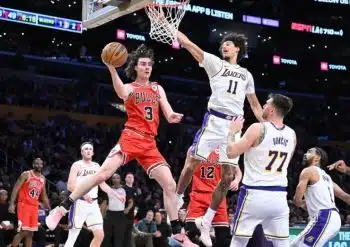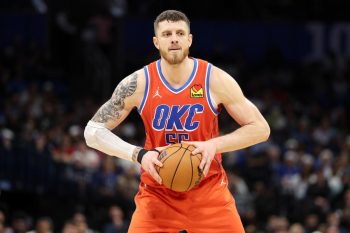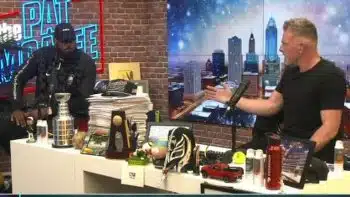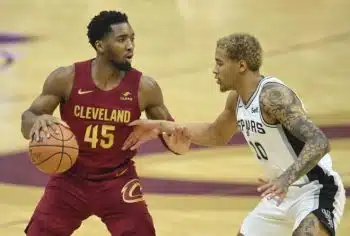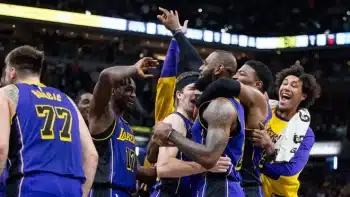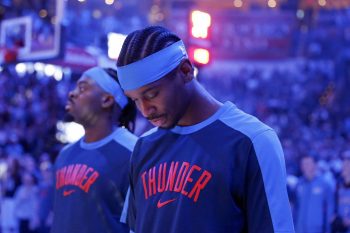NBA
Understanding Harden’s Restructured Contract
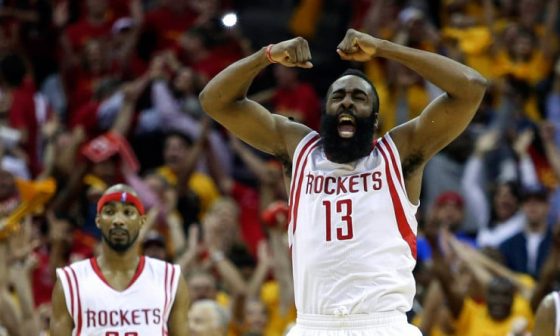
On July 9, the Houston Rockets took advantage of one of the many quirks of the Collective Bargaining Agreement, renegotiating and extending the contract of All-Star guard James Harden.
As detailed in May, Harden was one of almost 30 players who have qualified (or will qualify this summer) to have his contract restructured — available only to players with four or five years contracts, at least three years following their original signing date.
Additionally, renegotiation cannot lower salary; and teams must have enough cap-salary space to take advantage of the rule.
Others who may still restructure include Derrick Favors (Utah Jazz), Russell Westbrook (Oklahoma City Thunder) and Paul George (Indiana Pacers). Naturally, both sides need to consent to a deal.
Restructuring isn’t common, but the Denver Nuggets used their cap room last summer to re-work the contracts of Danilo Gallinari and Wilson Chandler. But Harden is unique in that he had two seasons left on his deal – paying $16.8 million for 2016-17 and $17.8 million for 2017-18.
Under his new contract, Harden will receive the following:
2016-17 — $26,540,100
2017-18 — $28,299,399
2018-19 — $30,421,854 (estimated)
2019-20 — $32,703,493 (estimated; player option)
Total — $117,964,846 (estimated)
The odd raise structure, year-to-year jumping by $1,759,299, $2,122,455 and $2,281,639 looks like a mistake, but it’s the proper application of a myriad of rules. Harden’s actual salary over the last two years of his deal won’t be set until the 2017-18 salary cap is officially announced.
Why wouldn’t Harden receive raises of $1,990,508 each year — 7.5 percent of his 2016-17 salary?
2016-17 — $26,540,100
2017-18 — $28,530,608
2018-19 — $30,521,115
2019-20 — $32,511,623 (player option)
Total — $118,103,445
The key is that Harden’s original contract covers the 2016-17 and 2017-18 seasons. His extension doesn’t actually start until 2018-19.
By the rules of extensions, Harden is eligible for a raise of 7.5 percent in 2018-19 over the final year of his original contract (2017-18, after it is renegotiated). Once the extension starts, the 2018-19 season is the basis for any subsequent raises, limited again to 7.5 percent, which determines his salary for 2019-20.
Technically, Harden and the Rockets could have agreed to an extension with a sizable pay-cut in 2018-19 — down by 40 percent from his 2017-18 salary — but Harden’s actual agreement is listed as a “maximum contract.”
(UPDATE: This next two paragraphs are flawed in regards to Harden’s 2017-18 salary, in that raises are not subject to the next season’s maximum salary. It does apply to his potential salary in 2018-19. Further explanation to follow.)
If that’s not already complex enough, there’s yet another wrinkle to the equation. In a memo distributed to teams earlier in the month, the NBA updated its salary cap projection for 2017-18 to $102 million, down from $107 million. With that, the maximum salary Harden is eligible to receive next year shrunk from roughly $29.7 million to the league’s current middle-tier max, or $28,299,399.
This matters because Harden is only eligible for a 7.5 percent raise over his 2016-17 salary if the resulting amount is no higher than the maximum salary. Harden may still earn that $28,530,608, but to get it he’ll need the salary cap to climb higher than $102 million. In fact, his actual salary could further shrink if the cap comes in lower than the current projection.
(UPDATE: The basis for Harden’s raise is actually 7.5 percent of the additional amount of $9,756,068 he received in renegotiated salary for 2016-17, which is $731,705. Harden’s original salary of $17,811,626 for 2017-18 is increased by both the same raise he received in 2016-17 ($9,756,068) and $731,705 to reach $28,299,399. Hat tip to cap expert Albert Nahmad of HeatHoops.com for his breakdown of Harden’s 2017-18 figure.)
Westbrook, in the final year of his deal, would be eligible for a three-year extension, after renegotiating his salary up to the same number Harden will receive for 2016-17.
2016-17 — $26,540,100 (2016-17 middle-tier maximum)
2017-18 — $28,530,608 (7.5 percent raise, first year of extension)
2018-19 — $30,670,403 (7.5 percent raise, $2.1 million raise based on first year of extension)
2019-20 — $32,810,199 (same $2.1 million raise)
Total — $118,551,310
As a free agent next summer, Westbrook won’t be able to earn more than the maximum, once set next July. If his future is in Oklahoma City, then restructuring gives the team a clear path forward. If not, the Thunder are probably better off looking for a trade.
Westbrook would be able to restructure and extend on a new team, provided they have the necessary cap room after a trade. Without that commitment from the All-Star guard, teams will be hesitant to give up as much to the Thunder for Westbrook.
The Boston Celtics are well-positioned to give the Oklahoma City a rich offer, with the cap space to renegotiate and extend Westbrook’s salary. The Los Angeles Lakers have held off signing players like second-overall pick Brandon Ingram, Tarik Black and Marcelo Huertas, protecting their remaining cap space, in case a trade opportunity should arise.
A number of teams would line up with offers, but that list shortens considerably without Westbrook agreeing to sign to a long-term deal immediately — and that may simply be a non-starter. Westbrook may want a Hamptons-like moment, similar to the one recently experienced by former teammate Kevin Durant.
Meanwhile, Favors has six years of NBA experience, and is eligible for the bottom tier max of $22,116,750. Currently he is set to earn $11,050,000 for 2016-17, but the Jazz could earmark their $11 million of cap space (available upon waiving the non-guaranteed Christapher Johnson) to give Favors a restructured and extended four-year deal starting at the maximum salary.
(UPDATE: Minor tweaks made to Derrick Favors’ figures, based on the logic applied from James’ Harden’s renegotiation.)
The following is the maximum restructured contract potentially available to Favors:
2016-17 — $22,116,750 (2016-17 bottom-tier maximum)
2017-18 — $23,896,756 ($11.1 million raise, plus 7.5 percent, in final year of original contract)
2018-19 — $25,689,013 (7.5 percent raise in first year of extension)
2019-20 — $27,615,689 (7.5 percent raise, based on first year of extension)
Total — $99,318,207
Extensions can also start at the maximum salary, but with a descending salary in subsequent seasons. The following is the minimum the Jazz can offer Favors, provided they start at the current season’s maximum:
2016-17 — $22,116,750 (2016-17 bottom-tier maximum)
2017-18 — $22,236,744 (7.5 percent decrease in final year of original contract)
2018-19 — $13,342,046 (40 percent maximum decrease in first year of extension)
2019-20 — $12,341,393 (7.5 percent decrease, based on first year of extension)
Total — $70,036,933
Should Favors finish out his contract, signing a new deal in 2018-19 at a projected max of $30.5 million (based on a projected cap of $108 million), he would earn a maximum of approximately $86.3 million from 2016-17 to 2019-20.
Why would Favors accept a renegotiation? At a maximum salary over four years, the easy answer is a lot more money, immediately. Even with lower raises, Favors stands to make more over the next three seasons than he would by finishing his contract, and then signing a maximum contract after the 2017-18 season.
The Jazz would benefit in locking in a young, core piece for two additional years.
A player option in the final year would allow Favors to hit free agency sooner, but then the Jazz are paying a lot for the next couple of seasons to lock in one more year with Favors.
Finding the exact sweet spot between $70.0 million and $99.3 million would be a negotiation between the team and Favors’ agent, provided both sides are open to lengthening their partnership.
Since Favors would be eligible for a similar renegotiation next summer, the Jazz might want to wait to lock him in for the maximum of four seasons, through 2020-21, but there’s no guarantee the same rules will be in place beyond the current Collective Bargaining Agreement, which is likely to be renegotiated after the 2016-17 season.
Qualifying Offer Deadline
Saturday is the deadline for teams to unilaterally withdraw outstanding qualifying offers to restricted free agent.
After July 23, the teams can rescind a qualifying offer — provided the player gives their consent. If so, the player is also renounced — the team losing Bird rights.
The following eight players remain restricted:
- Tyler Zeller — Boston Celtics — $3.6 million qualifying offer (QO)
- Donatas Motiejunas — Houston Rockets — $4.4 million QO
- Tarik Black — Los Angeles Lakers — $1.2 million QO
- Marcelo Huertas — Los Angeles Lakers — $1.1 million QO
- Miles Plumlee — Milwaukee Bucks — $3.1 million QO
- Mo Harkless — Portland Trail Blazers — $3.5 million QO
- Nando De Colo — Toronto Raptors — $1.8 million QO
- Bradley Beal — Washington Wizards — $7.5 million QO
Half of the list (Black, Huertas, Plumlee and Beal) have already agreed to terms to re-sign. De Colo will spend the season overseas — Toronto holding onto his restricted rights for down the road.
The players to monitor closely include Zeller, Motiejunas and Harkless.
Even if their qualifying offers are rescinded before the deadline, each can still re-sign with their respective teams — but they would immediately become unrestricted free agents.
Unsigned First-Rounders
On Friday, the New Orleans Pelicans announced the signing of Buddy Hield, the team’s sixth overall pick in June.
“We could not be more excited to add a player and person like Buddy Hield to the New Orleans Pelicans,” said General Manager Dell Demps in a statement. “He embodies all the traits we care about in our organization. His work ethic, energy and confidence have been on full display since he stepped foot in New Orleans. We look forward to helping him grow as a player as he will help us become a better team.”
The following eight 2016 first-round picks have yet to sign contracts:
- Brandon Ingram (2nd) — Los Angeles Lakers
- Jaylen Brown (3rd) — Boston Celtics
- Thon Maker (10th) — Milwaukee Bucks
- Donatas Sabonis (11th) — Oklahoma City Thunder
- Juancho Hernangomez (15th) — Denver Nuggets
- Guerschon Yabusele (17th) — Boston Celtics
- Ante Zizic (23rd) — Boston Celtics
- Furkan Korkmaz (26th) — Philadelphia 76ers
Some, like Yabusele, Zizic and Korkmaz will play overseas. The Lakers, Celtics, Bucks and Thunder are likely waiting to maximize their salary cap space before inking their respective lottery picks. Hernangomez is also expected to join the NBA this season.
